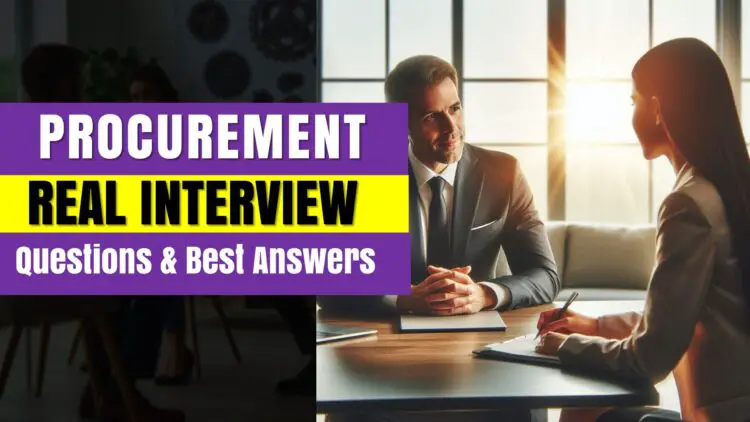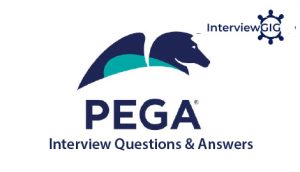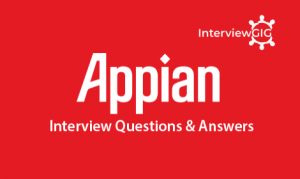In today’s dynamic and often disrupted global supply chain, procurement professionals are more critical than ever. It’s not just about cutting costs; it’s about strategic sourcing, risk mitigation, and building resilient supplier relationships. Landing a coveted procurement role in this evolving landscape demands more than textbook knowledge – it requires demonstrating how you’d navigate real-world challenges.
This blog post dives deep into situational interview questions that mirror the complexities of modern procurement, providing you with the best approaches and answer frameworks to showcase your strategic thinking and problem-solving prowess. Get ready to prove you’re not just a buyer, but a strategic value driver.
Question: Can you describe your experience in procurement and how it relates to the responsibilities outlined in this role?
Tip: Focus on relevant experiences and how they align with the job description.
Sample Answer:
“I have over five years of experience in procurement, primarily in the technology sector. In my previous role, I managed supplier relationships, handled purchase requisitions, and ensured compliance with procurement policies. This experience directly relates to this role, as I have successfully led procurement operations support and resolved day-to-day challenges, which aligns with your need for someone to improve user experience and support business operations.”
Question: What do you understand by the Source-to-Pay process? Can you explain the steps involved?
Tip: Focus on providing a clear and concise overview of the entire process, highlighting the key steps involved.
Sample Answer:
The Source-to-Pay (S2P) process is the end-to-end workflow for procuring goods and services. It includes the following key steps:
- Need Identification: Recognizing the requirement for goods or services.
- Supplier Selection: Evaluating and choosing suppliers.
- Contract Negotiation: Finalizing terms with the selected supplier.
- Purchase Order Creation: Issuing a formal request for the goods or services.
- Order Fulfillment: The supplier delivers the order.
- Receipt and Inspection: Checking the received goods or services for quality.
- Invoice Processing: Matching the supplier’s invoice with the purchase order and receipt.
- Payment Processing: Making payment to the supplier.
This process ensures efficient procurement and cost management.
Question: What is the difference between procurement and purchasing?
Tip: Highlight the broader scope of procurement compared to purchasing.
Sample Answer:
“Procurement is a strategic function that focuses on supplier selection, cost control, and contract management. Purchasing is an operational function that deals with processing purchase orders, confirming deliveries, and handling payments. Procurement looks at the long-term impact, while purchasing handles daily transactions.”
Question: In your own words, why is the Procurement function important to a company’s success?
Tip: Emphasize the strategic value of procurement.
Sample Answer: “To me, Procurement is really vital. At its core, it helps the company get everything it needs to run smoothly and efficiently. But it’s way more than just ‘ordering stuff’. Good procurement can actually save the company money by getting better deals, reduce risks in the supply chain, improve quality by finding good suppliers, and even drive innovation by working closely with those suppliers. Basically, a strong procurement function helps the company be more competitive and profitable in the long run. It hits the bottom line.”
Question: Can you walk us through the procurement strategy you have developed or implemented in your previous roles?
Tip: Use a specific example to illustrate your strategic thinking.
Sample Answer:
“In my previous role, I developed a procurement strategy focused on consolidating suppliers to achieve better pricing and terms. I conducted a thorough analysis of our spending patterns and identified key suppliers that could meet multiple needs. By negotiating long-term contracts with these suppliers, we were able to reduce costs by 15% and improve delivery times. This strategy not only saved money but also strengthened our relationships with key suppliers, ensuring we had reliable partners for future projects.”
Question: Can you explain the concept of total cost of ownership?
Tip: Define the concept clearly and highlight its importance in procurement decisions.
Sample Answer: “Total Cost of Ownership, or TCO, is basically looking at the real cost of something, not just the price tag you see initially. It’s like when you buy a car – the sticker price is just the beginning. You also have to factor in gas, insurance, maintenance, maybe repairs down the line. TCO in procurement is similar.
It includes the purchase price, sure, but also things like shipping costs, installation, training, ongoing maintenance, and even what it costs to dispose of it at the end of its life. So, when we’re making procurement decisions, TCO helps us see the whole picture and choose the option that’s actually the best value in the long run, not just the cheapest upfront.”
Question: What are some common “Payment Terms” used in procurement (e.g., Net 30, 2/10 Net 30)? Explain what “Net 30” means?
Tip: Provide examples of payment terms and explain their significance.
Sample Answer:
“Common payment terms in procurement include Net 30, Net 60, and 2/10 Net 30. ‘Net 30’ means that the full invoice amount is due within 30 days of the invoice date. This term allows the buyer a month to pay, which can help with cash flow management.
On the other hand, ‘2/10 Net 30’ means that if the buyer pays within 10 days, they receive a 2% discount; otherwise, the full amount is due in 30 days. These terms are important as they can influence cash flow and supplier relationships.”
Question: What is your approach to risk management in procurement?
Tip: Discuss your strategies for identifying and mitigating risks.
Sample Answer:
“For me, risk management in procurement is about being proactive and thinking ahead. It’s about asking, ‘What could go wrong, and how can we avoid it or lessen the impact?’ So, my approach usually involves a few steps. First, identifying potential risks – things like supplier financial problems, supply chain disruptions, quality issues, even price increases. Then, assessing how likely and how serious each risk is.
And finally, putting in place mitigation plans – like having backup suppliers, diversifying sources, closely monitoring key suppliers, or negotiating contract terms that protect us. It’s about being prepared and not getting caught off guard.”
Question: What is your experience with “preferred buying channels” and “through-to-pay” processes? How would you promote their use to business users?
Tip: Highlight your experience and strategies for promoting these processes.
Sample Answer:
“I have experience working with preferred buying channels, such as e-procurement platforms, which streamline the purchasing process and ensure compliance with company policies. In my previous role, I promoted the use of these channels by conducting training sessions for business users, demonstrating how they can save time and reduce costs. I also provided ongoing support to address any questions or concerns. By showcasing the benefits, such as easier access to approved suppliers and better tracking of purchases, I was able to increase adoption rates significantly.”
Question: Can you explain the difference between direct and indirect procurement?
Tip: Use examples to make the difference clear (e.g., “Steel for a car is direct, but office furniture is indirect”).
Sample Answer:
“Direct procurement involves purchasing materials used in production, like raw materials in manufacturing. Indirect procurement covers supporting goods and services, like office supplies, IT software, and consulting. Both are crucial, but direct procurement impacts the final product, while indirect helps operations run smoothly.”
Question: When evaluating potential suppliers, what key factors do you consider in the selection process? How do you balance cost, quality, lead time, and risk mitigation in your decision-making?
Tip: Highlight the criteria you use for supplier evaluation and how you prioritize them.
Sample Answer:
“When evaluating potential suppliers, I consider several key factors: cost, quality, lead time, and risk mitigation. Cost is important, but I also assess the quality of the products or services they offer, as poor quality can lead to higher costs in the long run. Lead time is crucial for ensuring that we can meet our production schedules. To balance these factors, I use a weighted scoring system that allows me to quantify each supplier’s strengths and weaknesses. Additionally, I conduct risk assessments to identify any potential issues, such as financial stability or compliance history, which helps me make informed decisions that align with our strategic goals.”
Question: What steps would you take to resolve a blocked invoice or incorrect payment?
Tip: Outline a clear process for addressing invoice issues.
Sample Answer:
“If I encounter a blocked invoice or an incorrect payment, I would first review the invoice details to identify the reason for the blockage. This could involve checking for discrepancies in pricing, missing approvals, or incorrect purchase order numbers. Next, I would communicate with the relevant stakeholders, such as the supplier, accounts payable team, and the requester, to gather additional information and clarify any misunderstandings. Once I have all the necessary details, I would work to resolve the issue by ensuring that any missing documentation is provided and that the invoice is corrected. Finally, I would follow up to ensure that the payment is processed promptly.”
Question: What is a “Purchase Requisition” (PR)? What information is typically included in a PR?
Tip: Define a Purchase Requisition clearly and list the key components.
Sample Answer:
*”A Purchase Requisition (PR) is an internal document used to request goods or services before issuing a Purchase Order (PO). It typically includes:
- Item details (description, quantity, unit price)
- Supplier name
- Cost center and accounting codes
- Approval workflow
- Justification for purchase
The PR ensures that purchases are budgeted, reviewed, and approved before committing to a supplier.”*
Question: How do you ensure accuracy and compliance when validating purchase requisitions?
Tip: Mention real errors (e.g., duplicate PRs, missing approvals) to show practical experience.
Sample Answer:
“I check if all required details—supplier, item description, quantity, pricing, approvals, and budget codes—are accurate and compliant with policies. Common errors include incorrect supplier details, duplicate requests, or missing approvals. I also ensure compliance with procurement policies and preferred vendor agreements before approving a PR.”
Question: How do you approach resolving supplier or payment issues, as mentioned in the “Interface with clients and suppliers on supplier and payment issues” responsibility?
Tip: Describe your communication and problem-solving strategies.
Sample Answer:
“When resolving supplier or payment issues, I take a proactive and collaborative approach. First, I ensure clear communication with both the supplier and internal stakeholders to understand the nature of the issue. I listen carefully to the concerns raised and gather all relevant information. If it’s a payment issue, I review the payment terms and any discrepancies in the invoice. I then work with the accounts payable team to address any internal processes that may have caused the delay.
Throughout the process, I maintain open lines of communication, providing updates to all parties involved until the issue is resolved. My goal is to foster strong relationships with suppliers while ensuring that our internal processes are efficient and transparent.”
Question: Describe your end-to-end experience with transactional procurement processes, specifically mentioning activities like requisition validation, PO creation, and order follow-up.
Tip: Provide a clear overview of your experience with each step in the process.
Sample Answer:
“I have extensive end-to-end experience with transactional procurement processes. It begins with requisition validation, where I ensure that all purchase requests are complete, accurate, and compliant with company policies. I check for necessary approvals and confirm that the requested items align with our budget and needs. Once validated, I create purchase orders (POs) in our procurement system, ensuring that all details, such as pricing and delivery terms, are correct.
After issuing the PO, I follow up with suppliers to confirm order receipt and track delivery timelines. I maintain communication with both the supplier and internal stakeholders to address any issues that may arise during the order fulfillment process, ensuring that we receive the goods on time and in the expected condition.”
Question: In which scenarios would you use an RFI, RFQ, or RFP? Can you provide an example of a time when you had to choose between these methods and how you ensured the best outcome for your organization?
Tip: Explain the differences between RFI, RFQ, and RFP, and provide a specific example.
Sample Answer:
“I would use an RFI (Request for Information) when I need to gather general information about potential suppliers and their capabilities. An RFQ (Request for Quotation) is appropriate when I have a clear understanding of my requirements and need to obtain pricing for specific goods or services. An RFP (Request for Proposal) is used when I seek detailed proposals for complex projects that require a comprehensive solution.
For example, in my previous role, we were looking to implement a new software solution. Initially, I issued an RFI to gather information about various vendors and their offerings. After narrowing down the options, I decided to issue an RFP to the top candidates, as we needed detailed proposals that included pricing, implementation timelines, and support services. This approach allowed us to compare the vendors comprehensively and select the one that best met our needs, ultimately leading to a successful implementation.”
Question: How do you manage procurement risks, particularly when dealing with global suppliers or high-value contracts?
Tip: Discuss your strategies for identifying and mitigating risks.
Sample Answer:
“I mitigate risks by conducting supplier due diligence, ensuring robust contract terms, and setting clear SLAs (Service Level Agreements). For global suppliers, I track geopolitical risks, compliance regulations, and currency fluctuations. In high-value contracts, I include penalty clauses for delays and set contingency plans for alternate sourcing.”
Question: Procurement professionals must stay ahead of market trends and price fluctuations. What data sources, tools, or methodologies do you use to analyze supplier pricing trends, market volatility, and cost-saving opportunities?
Tip: Mention specific tools and methodologies you use for analysis.
Sample Answer:
“I use a combination of internal data, market intelligence tools, and supplier benchmarking. I monitor pricing trends using sources like commodity price indexes, procurement dashboards, and supplier negotiations. Regular supplier comparisons and historical data analysis help me identify cost-saving opportunities and lock in the best pricing terms.”
I also leverage tools like Excel for data analysis, where I can track historical pricing data and identify patterns over time. By conducting regular spend analysis, I can pinpoint areas for potential cost savings and negotiate better terms with suppliers. Staying connected with industry networks and attending trade shows also helps me gain insights into emerging trends and opportunities.”
Question: How do you maintain procurement documentation for audit readiness?
Tip: Explain your process for organizing and storing procurement documents.
Sample Answer:
“Maintaining procurement documentation for audit readiness is crucial, and I follow a systematic approach to ensure everything is organized and accessible. I use a centralized document management system to store all procurement-related documents, including purchase requisitions, POs, contracts, and supplier communications. Each document is labeled clearly and categorized by supplier and project for easy retrieval.
Question: How do you approach vendor negotiations to secure optimal pricing, service levels, and long-term value for the company?
Tip: Highlight your negotiation strategies and focus on building relationships.
Sample Answer
“I see negotiation as finding a win-win. It starts with solid preparation – knowing our needs, market prices, and the supplier’s position. My approach is to be collaborative but assertive. I aim for the best possible price, of course, but also focus on securing favorable service levels and contract terms that create long-term value and a strong supplier relationship. It’s not just about the lowest price today, but a good deal that works well for both sides over time.”
Question: What is your approach to handling both catalog and non-catalog purchases? How do you ensure the correct process is followed?
Tip: Discuss your strategies for managing different types of purchases.
Sample Answer:
“For catalog purchases, I ensure the items are selected from the approved supplier catalogs to streamline ordering and compliance. For non-catalog purchases, I validate the need, identify the right supplier, and follow the appropriate process to ensure accuracy, transparency, and cost-effectiveness. Both types require strict adherence to procurement policies.”
Question: Describe your hands-on experience with SAP Ariba and S4 HANA in the context of procurement.
Tip: Mention specific modules (e.g., Supplier Management, Order Management) you worked with.
Sample Answer:
“I have used SAP Ariba to manage supplier catalogs, track procurement processes, and create purchase orders. With S4 HANA, I’ve integrated procurement workflows, validated requisitions, and monitored procurement performance through real-time data. Both tools have been essential for streamlining operations and improving efficiency in the procurement cycle.”
Question: Explain your experience in maintaining supplier catalogs and collaborating on new deployments.
Tip: Focus on data accuracy, user-friendliness, supplier collaboration, and the ongoing nature of catalog management.
Sample Answer:
“Maintaining catalogs is all about keeping the data accurate and user-friendly. I’ve experience updating pricing, adding new items, and removing obsolete ones. For new deployments, it’s about collaborating closely with suppliers to get their catalogs set up correctly in our system, ensuring data integrity from the start. Regular reviews and updates are important to make sure catalogs stay current and actually useful for our users.”
Question: How do you ensure customer and stakeholder satisfaction in your role, especially when handling procurement requests and issues?
Tip: Emphasize communication, responsiveness, problem-solving, understanding needs, and a proactive, customer-focused mindset.
Sample Answer
“For me, stakeholder satisfaction is a top priority. It’s about being responsive, clear in communication, and really understanding their needs when they come to procurement. When issues arise, I focus on quick and effective problem-solving, keeping stakeholders informed along the way. Proactive communication and a helpful attitude go a long way in building trust and ensuring they feel supported by procurement.”
Question: What strategies have you used to handle emergency procurement orders or expedite deliveries?
Tip: Emphasize supplier relationships and communication to manage emergencies effectively.
Sample Answer:
“For emergency procurement orders, I maintain strong relationships with key suppliers to ensure quick responses. I prioritize orders, negotiate faster delivery times, and use alternative sourcing methods when necessary. I also keep stakeholders informed about the status and manage expectations to avoid disruptions.”
Question: Describe your experience collaborating with cross-functional teams to resolve procurement issues.
Tip: Highlight your ability to work with different departments, understand their needs, and contribute to solutions collaboratively. Emphasize communication, teamwork, and positive outcomes.
Sample Answer:
“Collaboration is key in procurement, especially for solving issues. I’ve often worked with teams like Finance, Operations, and Legal to tackle procurement challenges. For example, when we had quality issues with a key component, I worked with the Engineering and Quality teams to define the exact problem, then with the supplier and our internal teams to find a solution. It’s about open communication, understanding everyone’s perspective, and working together towards a common goal.”
Question: Describe your experience with contract negotiation. What strategies do you use to achieve optimal pricing and terms?
Tip: Focus on your negotiation techniques and outcomes.
Sample Answer:
“I have extensive experience in contract negotiation, where I prioritize understanding both our needs and the supplier’s capabilities. My strategies include thorough market research to benchmark pricing, establishing clear objectives before negotiations, and building rapport with suppliers. For example, I successfully negotiated a long-term contract that reduced costs by 15% while securing favorable payment terms, which benefited both parties.”
Question: What’s your experience in handling emergency procurement orders? Can you give an example where you expedited an order successfully?
Tip: Provide a specific example that demonstrates your effectiveness.
Sample Answer:
“I have significant experience handling emergency procurement orders. One notable instance was when a key piece of equipment broke down unexpectedly, threatening a major project deadline. I quickly assessed our options and contacted a supplier who had the necessary part in stock. I negotiated expedited shipping and coordinated with our logistics team to ensure timely delivery. As a result, we received the part within 24 hours, allowing us to resume operations with minimal disruption.”
Question: What is your experience with e-procurement systems?
Tip: Mention specific systems you’ve used and your proficiency.
Sample Answer:
“I have hands-on experience with several e-procurement systems, including SAP Ariba and Coupa. In my previous role, I used these platforms to streamline the procurement process, manage supplier relationships, and track spending. I appreciate the efficiency these systems provide, such as automated purchase order creation and real-time reporting. My familiarity with e-procurement tools has helped improve compliance and reduce processing times significantly.”
–Ultimately, success in a procurement role hinges on your ability to contribute strategic value and navigate complex situations effectively. By understanding and preparing for these unique situational interview questions, you demonstrate to potential employers that you possess the critical thinking, negotiation acumen, and ethical considerations vital for today’s procurement landscape. Go beyond simply answering; showcase your ability to be a strategic partner, a risk mitigator, and a driver of sustainable value. With this preparation, you’ll be well-prepared to ace your interview and embark on a impactful procurement career.
Refer to our previous articles common interview questions, HR interview questions, behavioural interview questions, and job interview Conversion.




